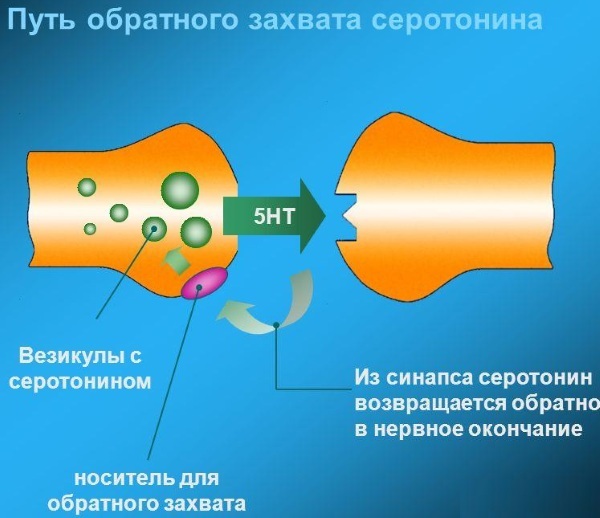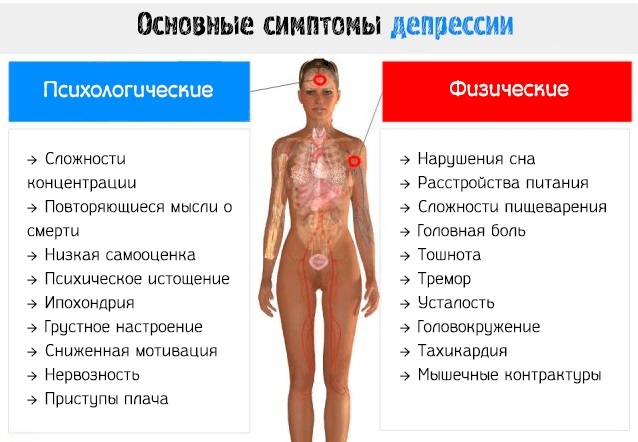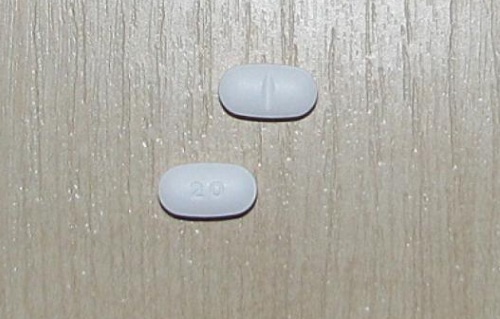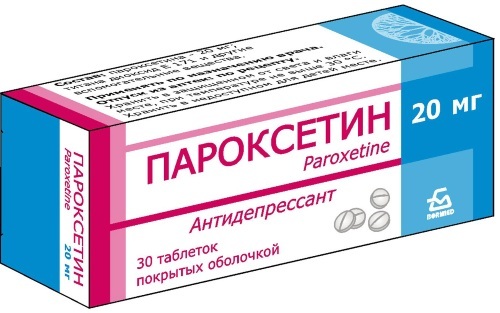Paxil is a potent drug that belongs to pharmacological category of antidepressants. According to reviews of patients taking this drug, its constituent components are highly therapeutic. Paxil is indicated for use in patients of the adult age group.
Record content:
- 1 Forms of release and composition of the drug
- 2 Pharmacological properties
- 3 Pharmacodynamics and pharmacokinetics
- 4 Indications for use
- 5 Contraindications
- 6 At what age can the drug be used?
- 7 Instructions for use, dosage
- 8 Side effects
- 9 Overdose
- 10 special instructions
- 11 Drug interactions
- 12 Analogs
- 13 Terms, conditions of sale and storage
- 14 Price
- 15 Video about the drug Paxil
Forms of release and composition of the drug
Paxil is available in the form of white oval tablets, coated with a protective coating, in the center of which there is a dividing line. The drug is packaged in plastic blisters of 10 tablets. in everyone. On top of the protective film of the tablets there is a branded engraving in the form of the number "20".
The main package of the medication is a cardboard box, inside which there is an instruction for the use of Paxil. 1 box of the drug can contain 1, 3 or 10 blisters with tablets, depending on the configuration of the drug.
The main component of the antidepressant is paroxetine hydrochloride hemihydrate with a concentration of 22.8 mg, which corresponds to the mass fraction of pure paroxetine 20 mg.
Excipients of the medication are the following chemical compounds:
- magnesium stearate at a dosage of 3.5 mg;
- hydrogen phosphate dihydrate in the form of 317.75 mg;
- sodium carboxymethyl starch with a mass fraction of 5.95 mg.
The presence of a protective shell of the drug is provided by auxiliary components in the form of hypromellose, polysorbate, titanium dioxide, macrogol. All the constituent components of Paxil are completely safe for the human body, and also do not have carcinogenic or toxic properties.
Pharmacological properties
Reviews of patients taking Paxil indicate that the medication has an excellent therapeutic effect.
This drug has the following pharmacological properties:
- eliminates acute panic attacks in persons who have mental, neurological or behavioral disorders;
- improves social adaptation in people who have changed the workforce, place of residence, are undergoing a period of psychological rehabilitation after a stressful situation;
- helps to get rid of feelings of inexplicable fear and anxiety, stabilizing the general psycho-emotional state;
- stimulates the body's receptors that are responsible for the perception of the hormone serotonin, which is automatically reflected in mood of a person (the patient becomes more cheerful, cheerful, sociable, symptoms of depressive states, apathy);
- has a pronounced sedative effect without suppressing consciousness and the functions of the central nervous system.
Paxil tablets can be used to treat pre-existing mental, neurological and behavioral disorders, or be used as a prophylactic agent, the use of which is aimed at preventing relapse disease.
Pharmacodynamics and pharmacokinetics
Paxil (reviews of patients taking the drug indicate a quick therapeutic effect) is an antidepressant, the pharmacodynamics of which is due to the action of its active substance. After entering the patient's body, paroxetine does not cause disruption of the central nervous system and psychomotor functions.
The main component of Paxil stimulates the sensitivity of 5-HT receptors, which are responsible for the identification of serotonin (the hormone of happiness), which ensures the achievement of an antidepressant effect. Paroxetine has no pronounced anticholinergic properties.

Paxil does not affect the performance of the heart muscle, does not inhibit the centers of the brain responsible for the implementation of the act of breathing, does not change the level of blood pressure and body temperature. The only exceptions are persons who initially have concomitant diseases of the cardiovascular and respiratory system.
In this case, additional consultation with the attending physician is required. In terms of its chemical composition, Paxil is qualitatively different from other antidepressants, most of which are made on the basis of tricyclic and tetracyclic components.
The pharmacokinetics of this drug is characterized by rapid absorption of its active component. After the drug enters the gastrointestinal tract, paroxetine is rapidly absorbed into the intestinal walls, saturating the bloodstream.
Together with the blood flow, the main substance of the antidepressant is evenly distributed in the tissues of the internal organs, and only 1% of the active component remains in the blood plasma. Paroxetine has a high biological activity, binding to proteins by 95%. Paxil metabolism occurs in the liver tissues, and the half-life of the drug lasts about 24 hours.
On average, 64% of the formed metabolites are excreted from the body by the kidneys in the urine. Along with the feces, about 36% of the half-life products of the drug are utilized.
Less than 1% of the drug is excreted unchanged. In patients over 65 years of age, as well as patients who suffer from renal or hepatic insufficiency, the period the half-life of paroxetine and the excretion of its metabolites can occur over a longer period time. In this regard, the concentration of the active substance in the blood plasma increases.
Indications for use
Paxil (reviews of patients who took the medication are 95% positive) is a drug that can only be prescribed by the attending psychiatrist or neurologist. The table below lists the indications for the use of this drug, and also describes the specifics of its action in a specific clinical case.
| Indications for the use of Paxil | The specificity of the action of the drug |
| Depression | Paxil is used to treat patients with signs of severe and moderate depressive conditions. Timely use of the medication allows you to bring the patient out of the state of apathy, return interest in life, restore communication skills, prevent the development of complications and the occurrence of negative consequences. |
| Recurrent disorder | This is a type of depressive state of the psyche, which is accompanied by frequent relapses. Regular use of Paxil for 1 year minimizes the risk of depression recurrence. |
| Obsessive compulsive disorder | In the process of treating this disease, Paxil is indicated for admission as a prophylactic and supportive agent that prevents the exacerbation of the disease. The average duration of therapy for OCD is at least 1 year, after which a stable therapeutic effect is observed. |
| Panic | Panic disorder is a disorder that is often associated with agoophobia and other social behavioral disorders. In this case, Paxil is used as the main treatment, supportive and preventive therapy. Regular intake of medication prevents recurrence of panic disorder. |
| Social phobia | Paxil is used for faster and more comfortable adaptation of a person to a new environment, workforce, place of residence. The drug allows you to overcome internal complexes and fears that are exacerbated when communicating with strangers. |
| Anxiety disorder | Regular intake of Paxil ensures stabilization of the patient's psycho-emotional state, eliminates seizures unreasonable anxiety, has a pronounced sedative effect without suppressing the functional activity of the centers brain. |
| Post traumatic disorder | The drug is used as an independent agent or in combination with other medications for faster recovery of the psyche, which has suffered as a result of stress situations. |
Paxil (reviews of patients taking an antidepressant indicate a prolonged effect of its the main component) is a potent drug that is prohibited from unauthorized application. Before starting to use the medication for the purpose of treating or ensuring the prevention of recurrence of the disease, it is necessary to undergo a preliminary examination of the body.
Contraindications
The antidepressant Paxil is categorically contraindicated for use in the presence of the following circumstances:
- childhood;
- individual intolerance to paroxetine or other constituents of the drug, which is expressed in the form of a weak or acute allergic reaction;
- simultaneous therapy with linezolid-based medicines;
- parallel administration of drugs, the active component of which is thioridazine;
- treatment with drugs that are MAO inhibitors (this pharmacological group includes medicines Moklobemide, Methylthioninium chloride);

- the state of pregnancy, as well as lactation of the child with breast milk.
When treating the elderly and patients suffering from chronic liver and kidney diseases, the dosage of Paxil should be reduced to the minimum values. These recommendations are mandatory, since the active substance of the drug can aggravate the painful condition of these organs.
At what age can the drug be used?
Paxil (reviews of patients who took the medication indicate its safe chemical composition) allowed for admission to men and women who have reached the age of 18 years.
This drug is not used to treat children and adolescents with signs of a depressive state due to the presence of a significant risk of suicidal thoughts and behavior.
Clinical studies of the drug have shown that in children and adolescents with mental and behavioral disorders that took Paxil, the tendency to suicide was manifested much more often than in adults patients.
Instructions for use, dosage
Paxil is taken no more than 1 time per day at the same time directly at the time of the meal. The drug must be swallowed whole without damaging the protective membrane. The presence of a dividing line that runs right through the center of the tablet allows it to be divided into 2 even parts. This is convenient for patients who are prescribed to receive 10 mg of the medication.
Depending on the type of mental or behavioral disorder, Paxil can be prescribed in the following dosage:
- depressive state requires taking the drug 20 mg per day for several months before complete disappearance of the corresponding symptoms (after 3 weeks of the therapeutic course, correction is possible dose);
- obsessive-compulsive disorder is treated with a daily intake of 40 mg of the medication per day, with a possible increase in the dose to 60 mg;

- panic attacks are eliminated by taking Paxil regularly with an initial dosage of 10 mg per day, which is gradually increased to 40 mg (if necessary, the maximum dosage may be 60 mg in a day);
- social phobia is treated with a daily dose of 20 mg of antidepressant;
- unreasonable attacks of anxiety and fear are eliminated with a therapeutic dose of Paxil 20 mg per day;
- post-traumatic stress disorder requires taking 20 mg of medication per day, with a possible increase in the maximum dosage of 50 mg per day.
The duration of Paxil therapy is determined individually by the attending physician, but in all without excluding clinical cases, the timing of antidepressant administration should continue for several months. Only in this case it will be possible to achieve a stable therapeutic effect with a minimum risk of a relapse of the disease.
Cancellation of Paxil should occur gradually with a decrease in dosage to 10 mg per day, which is taken within 1 week, and only then can antidepressant therapy be completely discontinued.
Side effects
Paxil is well tolerated by adult men and women who take the drug for a long period of time.
Despite this, the occurrence of the following side effects of the medication is not excluded:
- hemorrhage in the subcutaneous layer and mucous membranes with the formation of minor hematomas;
- thrombocytopenia (this side effect of the drug is extremely rare);
- allergic reactions in the form of itching of the skin, edema of epithelial tissues, urticaria, rash;
- increased blood cholesterol levels;
- drowsiness;
- nightmares;
- suicidal thoughts, as well as real attempts to commit suicide;
- sense of anxiety;
- hyponatremia;
- loss of appetite;
- panic attacks;
- confusion of consciousness;
- visual and auditory hallucinations;
- headache;
- tremor of the upper limbs;
- tachycardia;

- dizziness;
- cramps of the lower extremities;
- increased sweating;
- acute glaucoma;
- noise in ears;
- bradycardia;
- unstable blood pressure with a sharp increase or decrease in its indicators;
- blurred vision;
- internal bleeding;
- yawn;
- diarrhea;
- vomit;
- increased dryness of the oral mucosa;
- nausea;
- constipation;
- erectile dysfunction;
- violation of the menstrual cycle;
- delayed outflow of urine;
- the formation of peripheral edema;
- overweight gain;
- asthenic syndrome.
After an abrupt discontinuation of Paxil, side effects may also occur in the form of dizziness, fear and anxiety, heart palpitations, nausea, headache, and hand tremors. In case of the appearance of the listed symptoms, you should inform the attending physician.
Overdose
Violation of the rules for dosing the drug entails the development of general intoxication of the body, as well as the occurrence of symptoms, which was described in the section above. Also, the patient may develop an involuntary spasm of muscle fibers and a feverish state.
In the case of severe intoxication, the onset of a coma with a further lethal outcome is not excluded. Overdose treatment should be carried out in a poison control center. The patient's therapy is aimed at gastric lavage, control over physiological processes in the body. Patients of this category are shown taking sorbent preparations.
special instructions
Young patients between the ages of 18 and 25 who have been taking Paxil for a long period of time may experience suicidal ideation. This is especially true for patients suffering from severe depression. In patients with diabetes mellitus, changes in blood glucose levels are possible.
In this regard, it may be necessary to re-adjust the doses of insulin. People who have concomitant kidney disease associated with impaired filtration functions should take Paxil with extreme caution.

In patients with epilepsy, therapy with this antidepressant may exacerbate the disease. Laboratory studies of the pharmacological properties of Paxil have shown that the drug does not reduce the reaction rate and cognitive abilities.
Despite this, special care should be taken when working with hazardous equipment, as well as when driving.
Drug interactions
The simultaneous administration of Paxil with drugs of the following pharmacological groups is strictly prohibited:
- serotonergic drugs (possible development of serotonin syndrome with impaired 5-HT receptor function);
- Pimosit (the active substance of Paxil enhances the properties of this drug);
- enzymes that take part in the breakdown of the constituent components of medicines;
- Ritonavir as well as fosamprenavir;
- Procyclidine (there is an increase in the concentration of this drug in the blood plasma);
- anticonvulsant medications;
- muscle relaxants (various disorders of the functions of the neuromuscular block occur);
- nonsteroidal anti-inflammatory drugs based on acetylsalicylic acid (the risk of opening of gastric or intestinal bleeding, as well as ulcerative lesions of these organs digestion).
Patients who are taking other medications at the same time should inform their doctor about this. Otherwise, the occurrence of negative reactions of the body, provoked by the interaction of medications, is not excluded.
Analogs
There are the following antidepressants, which are analogs of Paxil, used to treat depressive conditions, anxiety, behavioral, panic and post-stress disorders:
- Adepress;
- Reksetin;
- Paroxetine;

- Plizil;
- Actaparoxetine.
All of the above drugs contain an identical active substance in the form of paroxetine. Prescription of medicines with similar properties is carried out by a psychiatrist or neurologist. The release of the drug is carried out exclusively on a prescription basis.
Terms, conditions of sale and storage
Storage of Paxil tablets should be carried out in a dark and cool room, where there is no access for children, and the ambient air temperature is not higher than +30 degrees Celsius. The surface of the medication should not be exposed to direct sunlight.
The shelf life of the drug is 3 years, after which the further use of the drug is contraindicated. To buy the antidepressant Paxil requires a prescription from your doctor.
Price
The cost of Paxil in pharmacies is 2060 rubles. per pack of 100 tablets. Paxil is an effective drug that is a potent antidepressant. Reviews of patients taking the medication indicate its positive effect on the psychoemotional state.
Long-term drug therapy allows you to get rid of panic attacks, feelings of anxiety, fear, self-doubt, and most social phobias. The duration of treatment with Paxil is several months, but in general it is determined individually by a psychiatrist. The antidepressant is not used to treat patients under the age of 18.
Video about the drug Paxil
Doctor's opinion about Paxil:

